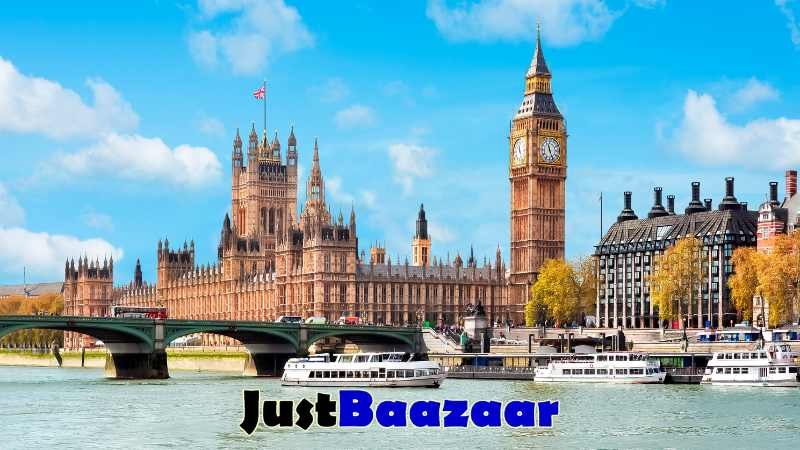Explore London: Time, Weather, Currency, Bridge, & More

CHAPTER 1 – London Time
Introduction:
In the bustling city of London, time is both a constant companion and a revered concept. From its early origins to the present day, the measurement and management of time have played a crucial role in shaping the culture and daily life of this historic metropolis. In this chapter, we will delve into the fascinating history of timekeeping in London, explore the importance of punctuality in its culture, examine Greenwich Mean Time (GMT), and discuss how daylight saving time impacts the lives of Londoners.
Evolution of Timekeeping:
Timekeeping in London has evolved significantly throughout history. In ancient times, sundials were used to track hours during daylight hours. However, with advancements in technology and society’s growing need for greater precision, mechanical clocks emerged during medieval times. These early clocks relied on weights or springs to power their mechanisms and became vital instruments for marking time within churches and other public spaces.
As trade expanded and navigation became more critical for exploration around the world, accurate timekeeping gained even greater importance. The establishment of Royal Observatory at Greenwich in 1675 marked a significant milestone in this regard.
Punctuality as a Cultural Virtue:
Londoners are renowned for their punctuality—a trait deeply ingrained within their cultural fabric. Whether it be business meetings or social gatherings, being on time is not merely expected but considered a sign of respect towards others.
This emphasis on punctuality can be traced back to various historical factors such as London’s status as a global hub for trade and commerce. In an environment where every second counts, lateness can cause significant disruptions that ripple through various aspects of daily life.
Greenwich Mean Time (GMT):
At the heart of London’s relationship with time lies Greenwich Mean Time (GMT). Established at the Royal Observatory in Greenwich by Sir George Airy in 1851, GMT serves as the standard reference point for measuring time worldwide.
Located at zero degrees longitude, Greenwich has been recognized as the prime meridian since 1884. This designation not only solidified London’s central role in global timekeeping but also established GMT as the foundation upon which all other time zones are based.
Daylight Saving Time:
London, like many other regions around the world, observes daylight saving time. Introduced during World War I to conserve energy, this practice involves advancing the clocks by one hour during summer months to maximize daylight hours in the evenings.
While daylight saving time is intended to improve energy efficiency and provide more leisure opportunities for Londoners, it does come with its own set of challenges. The adjustment can disrupt sleep patterns and affect productivity in certain industries, but overall it is widely accepted and integrated into daily life.
Conclusion:
Time is an omnipresent force that shapes every aspect of life in London. From its rich history of timekeeping to the cultural significance of punctuality, this city thrives on a shared understanding and respect for the value of each passing moment. Greenwich Mean Time anchors London’s position as a global epicenter for temporal measurement while daylight saving time brings both benefits and challenges to daily routines.
In our next chapter on London Weather, we will explore how this captivating city experiences a diverse range of climatic conditions throughout the year and how locals adapt accordingly to make the most out of their vibrant lives amidst unpredictable weather patterns.
Chapter 2 – London Weather
Introduction:
London is known for many things, but its weather is perhaps one of the most unpredictable aspects of the city. From sudden rain showers to unexpected bursts of sunshine, Londoners have learned to adapt and embrace the ever-changing climate that graces their beloved city. In this chapter, we will explore the influence of geographical factors on London’s weather patterns, examine how Londoners navigate through different seasons, and discover how weather impacts iconic landmarks.
Geographical Factors:
Situated in southeastern England, London’s climate is heavily influenced by its proximity to the North Atlantic Ocean and prevailing westerly winds. These factors contribute to a temperate maritime climate that is characterized by mild winters and relatively cool summers. However, it’s important to note that the term “temperate” can be misleading as London experiences a wide range of weather conditions throughout the year.
Weather Patterns:
London’s weather patterns are notorious for their variability. Rainfall is a common occurrence throughout the year, with an average of 106 rainy days annually. The highest rainfall typically occurs during autumn and winter months, while spring tends to be drier. Summers are generally pleasant with temperatures ranging between 20-25 degrees Celsius (68-77 degrees Fahrenheit), although heatwaves can occasionally push temperatures even higher.
Londoners’ Adaptation:
Londoners have become experts at adapting their daily routines according to the prevailing weather conditions. On any given day, you will see locals equipped with umbrellas or raincoats ready to face an unexpected downpour. Layering clothing is also a common practice as temperatures can fluctuate throughout the day.
Another aspect of adaptation lies in altering plans based on changing weather forecasts. Outdoor activities such as picnics in Hyde Park or visiting gardens like Kew Gardens are popular during sunny spells but may require rescheduling during inclement weather.
Impact on Iconic Landmarks:
Weather plays a significant role in shaping the experience of visiting iconic landmarks in London. For instance, the renowned Chelsea Flower Show, held annually in May, showcases stunning floral displays that are heavily dependent on favorable weather conditions leading up to the event. Similarly, attractions like Buckingham Palace and Tower of London have outdoor spaces that are best enjoyed during clear skies.
On the other hand, some landmarks have embraced their association with London’s weather quirks. The Millennium Bridge, famous for its distinctive design and pedestrian-only access, occasionally sways when strong winds blow across the River Thames. This phenomenon has become part of its charm and draws visitors who wish to experience this unique feature.
Conclusion:
London’s weather is as diverse as its multicultural population. Although it can be unpredictable at times, Londoners have learned to embrace every aspect of it. From carrying umbrellas as a fashion statement to enjoying sunny days in lush parks or exploring indoor attractions during inclement weather – Londoners adapt seamlessly to their ever-changing climate.
As we continue our journey through this book about London, we will dive deeper into other aspects that contribute to the vibrant life in this extraordinary city. Join us in the next chapter as we explore the fascinating world of currencies that have shaped London’s financial landscape throughout history.
Chapter 3 – London Currency
Introduction:
London, a city steeped in history and culture, has been a hub for trade and commerce for centuries. Throughout its rich past, various currencies have circulated within its bustling streets. From ancient Roman coins to the modern-day pound sterling (GBP), London’s currency has evolved alongside its growth as a global financial center. In this chapter, we will explore the fascinating world of London’s currency, delving into its historical significance, the impact of exchange rates on residents and tourists alike, and even touch upon the rise of digital currencies within certain sectors.
Historical Overview: From Farthings to Pounds Sterling
To truly understand London’s current currency landscape, we must take a step back in time. The city’s currency journey began with Roman coins known as “denarii” trading hands during their occupation of Britain. Over the centuries that followed, various coins such as farthings and groats became familiar sights in London’s vibrant markets.
However, it was not until King Henry VII introduced the pound sterling in 1489 that London established itself as an international financial powerhouse. The pound sterling quickly gained recognition for its stability and value across Europe. Its association with the British Empire further solidified its status as one of the world’s most influential currencies.
Exchange Rates: Navigating Financial Waters
For both residents and tourists in London, understanding exchange rates is crucial when dealing with foreign currencies. As an international city attracting visitors from all corners of the globe, fluctuations in exchange rates can greatly impact daily life.
Tourists planning their visit to London must consider how favorable or unfavorable exchange rates will affect their spending power during their stay. Additionally, businesses operating within the city must navigate fluctuating exchange rates when engaging in international trade or conducting business transactions abroad.
To mitigate these challenges, numerous avenues exist for exchanging currency in London. Banks offer convenient services for both residents and tourists seeking to convert their funds. ATMs are also widely available throughout the city, allowing visitors to withdraw cash in the local currency. Alternatively, currency exchange bureaus offer specialized services dedicated solely to exchanging various currencies.
The Rise of Digital Currencies:
While traditional currencies like the pound sterling continue to dominate London’s financial landscape, digital currencies have started gaining traction within certain sectors. Bitcoin, a decentralized digital currency, has seen increased acceptance among businesses and individuals seeking alternative payment methods.
In London, tech-savvy entrepreneurs and innovative startups have embraced cryptocurrencies as a means of conducting transactions. Some establishments even accept Bitcoin as payment for goods and services. However, it is worth noting that widespread adoption of digital currencies in everyday transactions is still in its infancy.
Conclusion:
London’s currency journey reflects its role as a global financial center and its rich historical legacy. From ancient Roman coins to the pound sterling, the city’s monetary history has shaped its identity as an economic powerhouse. Understanding exchange rates is essential for both residents and tourists navigating London’s vibrant streets.
As we move further into the 21st century, digital currencies like Bitcoin provide an intriguing glimpse into the future of finance in London. While traditional forms of currency will undoubtedly continue to dominate daily life for now, it is worth keeping an eye on how these emerging technologies may shape London’s financial landscape in years to come.
London Currency offers a fascinating glimpse into the intricate world of money matters within this diverse city standing at the crossroads of history and modernity.
Chapter 4 – London Bridge
Introduction:
London is a city renowned for its rich history and iconic landmarks, and perhaps none is more synonymous with the city than its bridges. In this chapter, we will delve into the fascinating world of London’s bridges, with a special focus on the famous Tower Bridge. We will explore their historical significance, the engineering marvels behind their construction, and how they have become cherished symbols of the city.
The Rich History of London Bridges:
To truly understand the significance of London’s bridges, we must step back in time. The city has been home to numerous notable bridges throughout history, each playing a vital role in connecting different parts of London. From Westminster Bridge to Millennium Bridge, these structures not only served as crossing points but also witnessed significant moments in British history.
Westminster Bridge stands as an enduring testament to architectural advancements made over time. Its elegant design and strategic location have made it one of London’s most beloved landmarks. Similarly, Millennium Bridge reflects modern engineering techniques while seamlessly blending with its surroundings.
Renovations and Improvements:
Throughout the years, many of these historic bridges have undergone major renovations or improvements. These efforts aim not only to preserve their structural integrity but also enhance their aesthetic appeal for future generations to appreciate fully.
One such example is Blackfriars Bridge which underwent significant refurbishments in recent years. Its original iron structure was upgraded with solar panels that now harness renewable energy to power parts of the bridge itself. This innovative approach showcases how historical infrastructure can be adapted to meet modern environmental needs.
Bridges as Tourist Attractions:
London’s bridges have become more than mere transportation links; they are now destinations in their own right due to their historical and architectural value. Visitors from all over the world flock to admire these awe-inspiring structures that bear witness to centuries of human ingenuity.
Tower Bridge stands tall as an iconic symbol representing both London’s past and present glory. Its majestic towers, intricate detailing, and the ability to lift its central section to allow tall ships to pass through make it a sight to behold. The Tower Bridge Exhibition offers visitors an opportunity to explore its inner workings and learn about its fascinating history.
Connecting Material:
As we explore the significance of London’s bridges, it becomes evident that they not only serve as physical connections but also connect us with the city’s past and present. Like the bridges themselves, London is a city that spans time, linking ancient traditions with modern innovations.
Conclusion:
In this chapter, we have delved into the historical importance of London’s bridges, highlighting their architectural marvels and how they have become cherished symbols of the city. From Westminster Bridge to Millennium Bridge and Tower Bridge, these structures not only facilitate movement but also provide a glimpse into London’s rich heritage.
Just as these bridges connect different parts of the city physically, they also connect us emotionally with our collective history. As we traverse these remarkable structures or gaze upon them from afar, we are reminded of London’s enduring spirit – one that stands strong in both times gone by and those yet to come.
The next chapter will transport us from physical connections to aerial ones as we explore flights to London – another gateway into this magnificent city.
CHAPTER 5: Flights to London
Introduction:
Flying to London is an exciting experience that opens up a world of possibilities. Whether you are a tourist looking to explore the vibrant streets of the city or a resident returning home, there are several aspects to consider when it comes to flights. In this chapter, we will delve into popular airlines and airports offering flights to London, discuss flight options available, and analyze how flight availability and frequency impact tourism and business in the city.
Popular Airlines and Airports:
When it comes to flying into London, there are numerous popular airlines that offer convenient routes from various destinations worldwide. From long-haul international flights to short domestic trips, airlines such as British Airways, Virgin Atlantic, Emirates, Lufthansa, and American Airlines have established themselves as trusted carriers for travelers heading towards the capital.
As for airports in London, two major hubs stand out: Heathrow Airport and Gatwick Airport. Heathrow is one of the busiest airports in the world and serves as a gateway connecting different continents. It offers direct flights from major cities across the globe and provides passengers with excellent facilities such as lounges, shopping areas, restaurants, and efficient transportation connections into central London.
Gatwick Airport is another significant airport located south of London. While not as large as Heathrow in terms of passenger traffic, it still handles millions of travelers each year. Gatwick offers both domestic and international flights with various airlines catering to different destinations. With its modern amenities and accessibility via public transportation links like trains or buses, Gatwick provides an alternative option for those seeking convenience.
Flight Options:
Travelers flying into London have a wide array of flight options available at their disposal. Depending on their preferences or budgetary constraints, they can choose between direct or connecting flights.
Direct flights offer convenience by eliminating layovers while providing a seamless journey from departure point straight into one of London’s airports. These flights are particularly popular for travelers who want to minimize travel time and avoid the hassle of changing planes. Moreover, direct flights can often be more expensive due to their convenience factor.
On the other hand, connecting flights involve a layover at another airport before reaching the final destination of London. While this may add some extra travel time, it can also present an opportunity for travelers to explore another city or country briefly. Connecting flights are usually more affordable compared to direct ones and offer a chance to break up a long journey.
Examining Flight Options:
To better understand flight options available for those traveling to London, let’s examine three different scenarios:
1. Compare prices and convenience of different airlines for various destinations:
Suppose you are planning a trip from New York City to London. By comparing prices and convenience, you might find that British Airways offers direct flights which may be more expensive but saves you valuable time. However, if budget is your primary concern, you could opt for a connecting flight with Delta or American Airlines via their respective hubs such as Atlanta or Chicago.
2. Exploring the experience of flying into major airports like Heathrow or Gatwick:
If your flight lands at Heathrow Airport, you will be greeted with its impressive infrastructure and efficient services designed to cater to millions of passengers daily. From immigration procedures to baggage claim and transportation options into central London, Heathrow ensures smooth operations throughout your arrival process.
At Gatwick Airport, although slightly smaller in scale compared to Heathrow, you will still encounter modern facilities such as duty-free shopping areas and restaurants where you can grab a bite after your journey. Both airports offer excellent connectivity through public transport systems like trains or buses that whisk visitors directly into the heart of London.
3. Analyzing how flight availability and frequency impact tourism and business in London:
The availability and frequency of flights play a crucial role in determining tourism flow into London as well as facilitating international business transactions.
Tourists are drawn towards London due to its rich history, cultural landmarks, and vibrant lifestyle. Therefore, a robust network of flights with good availability is essential in attracting visitors from all corners of the globe. Additionally, frequent flights contribute to increased tourism revenue as tourists can plan shorter trips or even weekend getaways without worrying about limited flight options.
For business travelers, having multiple flight options and frequencies allows for more flexibility in scheduling meetings and attending conferences. It fosters connections between London-based businesses and companies worldwide by facilitating efficient travel arrangements. The availability of direct flights between major financial centers like New York City or Hong Kong further strengthens London’s position as a global business hub.
Conclusion:
Flights to London offer an exciting gateway into the city’s vibrant atmosphere. With popular airlines providing convenient routes from various destinations and major airports like Heathrow and Gatwick offering excellent facilities, travelers have ample choices when it comes to flying into the capital. Whether opting for direct flights or connecting journeys, the availability and frequency of flights play a significant role in driving tourism and facilitating international business connections.
CHAPTER 6 – Life in London
Introduction:
London, the bustling metropolis, is a city that pulses with life. Its cultural diversity, vibrant neighborhoods, and endless array of activities make it a place like no other. In this chapter, we will explore the various aspects of life in London that contribute to its unique charm and allure.
Exploring the Neighborhoods:
London is a city of neighborhoods, each with its own distinct character and charm. From the historical grandeur of Westminster to the trendy streets of Shoreditch, every corner offers something different to its residents and visitors alike. Let’s take a closer look at some of these neighborhoods:
Westminster: As the political heart of London, Westminster is home to iconic landmarks such as Big Ben and the Houses of Parliament. The area exudes an air of history and power, attracting tourists who wish to experience the grandeur firsthand.
Shoreditch: Known for its vibrant street art scene and trendy bars, Shoreditch is a haven for artists and creatives. Its eclectic mix of shops and independent boutiques adds to its bohemian charm.
Camden Town: Famous for its alternative music scene and bustling markets along Regent’s Canal, Camden Town draws in crowds seeking unique fashion finds or exploring diverse street food options.
Daily Routines:
Life in London follows a fast-paced rhythm dictated by work hours and commutes. The typical workday usually starts around 9 am or earlier for those working in offices or corporate settings. The city’s efficient transportation system makes commuting relatively smooth despite occasional rush-hour congestion.
Londoners often rely on public transportation options such as buses or underground trains (known as “the Tube”) to navigate through this sprawling city. While rush hour can be crowded at times, it offers an opportunity to observe the diverse mix of people going about their daily lives.
Popular Activities and Attractions:
London offers an abundance of activities catering to every interest. The city’s vibrant cultural scene ensures that there is always something happening, from world-class theater shows in the West End to art exhibitions in renowned galleries like the Tate Modern.
Multiculturalism is celebrated through various festivals and events throughout the year. Notable examples include Notting Hill Carnival, which showcases the rich Caribbean heritage of London’s residents, and Diwali celebrations in Trafalgar Square, where the city comes alive with colorful lights and Indian music.
Food lovers will find themselves spoiled for choice in London. The culinary scene is a melting pot of international flavors, with restaurants serving cuisine from every corner of the globe. From traditional British pub fare to Michelin-starred fine dining experiences, there is something to satisfy every palate.
Sports enthusiasts can indulge in their passions as well. Whether it’s cheering on their favorite football team at Wembley Stadium or catching a cricket match at Lord’s Cricket Ground, London offers a wide range of sporting events for fans to enjoy.
Connecting Material:
As we delve into life in London, it becomes evident that time plays a crucial role in shaping daily routines and activities. From catching the Tube during rush hour to ensuring punctuality for theater shows or sporting events, being mindful of time is essential. The concept of timekeeping explored in Chapter 1 – “London Time” intertwines with our understanding of life in this bustling city.
Conclusion:
Life in London is an exhilarating blend of history, culture, and diversity. The neighborhoods offer unique experiences while daily routines reflect the fast-paced nature of this global city. With an array of activities and attractions catering to all interests, residents and visitors alike can immerse themselves fully into the vibrant lifestyle that defines London.
Next Chapter Preview – “London Currency”:
In Chapter 7 – “London Currency,” we will explore how money moves within this financial hub. We will dive into the historical importance of pound sterling as a global currency and discuss the impact of currency exchange rates on residents and tourists. Additionally, we will examine the rise of digital currencies and their growing popularity in certain sectors of London’s economy. Stay tuned as we unravel the monetary landscape of this dynamic city.









